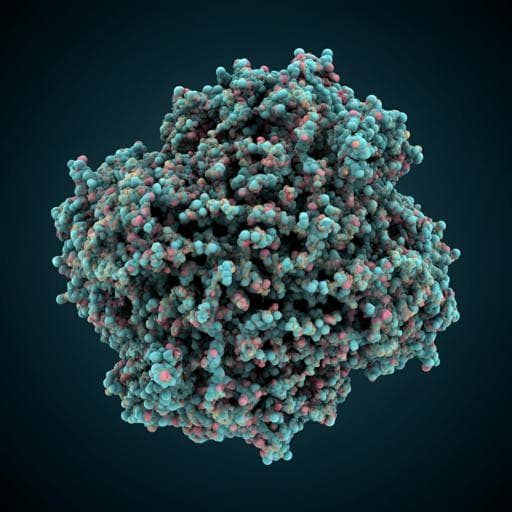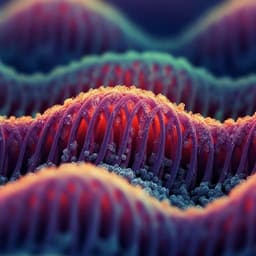
Chemistry
A 13-million turnover-number anionic Ir-catalyst for a selective industrial route to chiral nicotine
C. Yin, Y. Jiang, et al.
Discover groundbreaking advancements in asymmetric hydrogenation with our ultra-efficient anionic Ir-catalyst, achieving remarkable enantioselectivities and million turnover numbers. This breakthrough, detailed by authors Congcong Yin, Ya-Fei Jiang, Fanping Huang, Cong-Qiao Xu, Yingmin Pan, Shuang Gao, Gen-Qiang Chen, Xiaobing Ding, Shao-Tao Bai, Qiwei Lang, Jun Li, and Xumu Zhang, paves the way for industrial-scale production of enantiopure nicotine at an unprecedented scale!
~3 min • Beginner • English
Introduction
Industrial-scale production of chiral molecules demands catalysts that combine excellent enantioselectivity with very high turnover numbers (TONs) and turnover frequencies (TOFs), especially for asymmetric hydrogenation of ketones, including nitrogen-containing substrates relevant to pharmaceuticals. State-of-the-art Noyori-type outer-sphere catalysts deliver high enantioselectivity (>98% ee) but typically achieve only up to a few million TONs and modest TOFs for aryl alkyl ketones, and are particularly limited for nitrogen-containing ketones (historically ≤10,000 TON). The authors aim to surpass these limits by designing highly stable, enantioselective, and reactive catalysts through integrating anionic metal complexes—expected to enhance hydricity and rates—with multidentate ligation to stabilize an 18-electron, coordination-saturated, chiral environment. The research question is whether an anionic Ir catalyst bearing a tetradentate PNNO ligand can achieve biocatalysis-like efficiency (≥10 million TONs, high TOF) with excellent ee across ketones, including basic nitrogen-containing substrates, and enable a practical industrial route to enantiopure nicotine.
Literature Review
Outer-sphere hydrogenation catalysts avoid direct substrate coordination at the metal center, allowing highly selective and stable systems. Classical Noyori-type catalysts include Ru(bisphos)(diamine) systems and Ir-PNN complexes that operate via NH/MH bifunctional mechanisms and are effective for ketone hydrogenation. Zhou’s tridentate Ir-PNN catalyst set a prior benchmark of 4,550,000 TON at 98% ee. However, catalysts for nitrogen-containing ketones generally exhibited severe limitations, with reported TONs up to only ~10,000. Historical anionic hydride catalysts (e.g., Pez, Poli) demonstrated that anionic metal hydrides can display high hydricity and activity for carbonyl hydrogenation, but lacked the chiral, multidentate environment leveraged here. The present work builds on these concepts by employing an anionic, multidentate Ir system to enhance hydricity, stability, and asymmetric induction.
Methodology
Catalyst design and preparation: A tetradentate PNNO ligand (f-phamidol) was combined with [Ir(COD)Cl]2 to form monochloride dihydride Ir precatalysts. Under basic conditions (e.g., NaOtBu in iPrOH, H2 pressure), deprotonation of the ligand OH forms tetra-coordinated anionic Ir-ate dihydride complexes (confirmed by HRMS, in situ HP-ATR-IR, HP NMR, Raman, XRD, and DFT). Control ligands (NH-methylated, O-methylated, and sterically/electronically modified variants) were synthesized to assess the role of the OH donor in activity and selectivity.
Catalytic optimization (acetophenone benchmark): Reactions were performed at ambient temperature with very high substrate/catalyst (S/C) ratios. Using acetophenone (80 mmol) at S/C ≈ 2,000,000 and NaOtBu base yielded >99% ee and up to 99% conversion in 16 h. Solvent (iPrOH) was necessary for high ee and TON. High-turnover experiments varied S/C from 5,000,000 to 15,380,000, achieving 4,835,000–11,535,000 TON at 75–97% conversion and 99% ee, indicating excellent durability. A maximal-scale experiment with 800 mmol acetophenone at 100 bar H2 for 30 days gave 89.5% conversion, 99% ee, and 13,425,000 TON. Initial TOF (224 s−1) was determined from hydrogen pressure-drop curves.
Substrate scope and scale-up: Nitrogen-containing ketones were evaluated. Ketone S2 (amide) gave >99% ee, 97% conversion, and 970,000 TON at gram scale. Ketone S3 (amide plus pyridine) achieved >99% conversion, >99% ee, and 1,000,000 TON at gram scale. Substrate S4 was hydrogenated at 40 kg scale with S/C = 60,000. A laboratory route to chiral nicotine from S4 was established in three steps, affording nicotine in 99% ee and 68% overall yield.
Industrial implementation: A 2000 L CSTR processed ketone S4 using iPrOH, KOH base (economical alternative to NaOtBu), and 26 bar H2. Stepwise scale-up from 270 to 500 kg at S/C of 60,000 delivered full conversion and 98.9% ee in 2 h. At S/C 80,000–100,000 and 500 kg, reactions completed in 3–4.5 h with 99.6–99.7% conversion and 98.7–98.8% ee. Using recycled solvent at 500 kg and S/C 100,000 afforded the chiral alcohol intermediate with 99.7% conversion, 98.7% ee, 100,000 TON, catalyst load 0.045 g kg−1 product, and space-time yield 55.6 g L−1 h−1. This process enabled production of 40 tons of enantiopure nicotine.
Characterization and mechanism: Spectroscopic evidence (HRMS, HP-IR, NMR) and DFT established formation of anionic Ir-ate dihydrides with cis-hydrides; OH deprotonation is far more favorable than NH deprotonation. Ligand modification studies confirmed the crucial role of the anionic OH donor in enabling high TON and ee. DFT explored both NNa/MH and a novel ONa/MH bifunctional outer-sphere mechanism. For the active anionic complex, the ONa/MH pathway leading to the observed enantiomer has a lower barrier (6.2 vs 10.1 kcal mol−1). Including explicit solvent yields a computed barrier (~12.9 kcal mol−1) compatible with experimental TOF. Preliminary kinetics indicated unusual partial orders: ~1.9 in H2 and ~1.5 in Ir concentration. Theoretical orbital analysis (DFT/CASSCF) based on a 3-center-4-electron model rationalized enhanced hydricity due to elevated Ir 5d orbital energies upon anionic ligation, increasing hydride electron density and reactivity.
Representative procedures: Detailed 10-million-TON lab protocol (S/C = 15,000,000; 800 mmol acetophenone; 100 bar H2; 30 d; 89.5% conv., 99% ee, TON 13,425,000) and a 40 kg scale hydrogenation of S4 (CSTR, KOH, 30–45 °C, 5 h to complete, crude product 99% yield, 99% ee) followed by downstream processing to (S)-nicotine (68% overall yield, 99% ee) are provided.
Key Findings
- Record performance for acetophenone: 13,425,000 TON, 99% ee, and initial TOF 224 s−1 at room temperature under 100 bar H2; sustained high performance across S/C up to ~15.4 million with 75–97% conversion and 99% ee.
- Challenging nitrogen-containing ketones: S2 (amide): 97% conversion, >99% ee, 970,000 TON (gram scale). S3 (amide + pyridine): >99% conversion, >99% ee, 1,000,000 TON (gram scale). S4: successful at 40 kg scale (S/C 60,000).
- Industrial scale-up: 500 kg batches at S/C 60,000–100,000 under 26 bar H2 with KOH base achieved 99.6–99.7% conversion and 98.7–98.9% ee in 2–4.5 h; recycled solvent viable. Enabled production of 40 tons of enantiopure nicotine. Catalyst loading as low as 0.045 g per kg product; space-time yield 55.6 g L−1 h−1.
- Mechanistic insight: Anionic Ir-ate dihydrides form via OH deprotonation; spectroscopic and DFT evidence supports a preferred ONa/MH bifunctional outer-sphere mechanism with lower barrier (6.2 kcal mol−1) compared to NNa/MH (10.1 kcal mol−1). Explicit-solvent model yields a 12.9 kcal mol−1 barrier consistent with measured TOF.
- Kinetics: Non-integer reaction orders observed (≈1.9 in H2, ≈1.5 in Ir), indicating mechanistic complexity.
- Ligand structure–activity: The tetradentate PNNO ligand’s anionic OH donor is essential; methylation at OH drops performance (TON 33,000; 76% ee), NH methylation reduces but retains activity (TON 100,000; 95% ee), and a variant unable to form the anionic Ir-ate shows poor outcomes (TON 7,000; 35% ee).
Discussion
The integration of an anionic Ir center with a tetradentate PNNO ligand produces a highly stable, outer-sphere hydrogenation catalyst that delivers biocatalysis-like rates and unprecedented TONs while maintaining excellent enantioselectivity. This directly addresses the long-standing challenge of combining high ee with multi-million TONs, especially for nitrogen-containing ketones that typically deactivate catalysts. The mechanistic finding that an ONa/MH bifunctional pathway is preferred over traditional NNa/MH provides a new paradigm for outer-sphere asymmetric hydrogenation. Spectroscopic and computational evidence links enhanced hydricity to the anionic donor’s elevation of Ir 5d orbital energies and increased hydride electron density. Translation from lab to industry, including operation at modest H2 pressure and with inexpensive KOH, demonstrates robustness and practicality, culminating in an efficient, selective route to enantiopure nicotine at tens-of-tons scale. These results expand the design space for homogeneous hydrogenation catalysts and suggest broader applicability to other challenging carbonyl reductions in fine chemicals manufacture.
Conclusion
An ultra-efficient anionic Ir catalyst bearing a tetradentate PNNO ligand achieves record 13-million TONs, 224 s−1 TOF, and >99% ee for acetophenone hydrogenation and unprecedented 1-million TONs with 99% ee for nitrogen-containing ketones. Mechanistic studies reveal a novel, energetically preferred ONa/MH bifunctional outer-sphere pathway and rationalize enhanced hydricity via 3c–4e interactions modulated by anionic ligation. The catalyst’s stability, selectivity, and scalability enabled a selective industrial route to enantiopure nicotine, already realized at 40 tons of product. Future work may extend this anionic, multidentate-ligation strategy to other substrates and processes in the production of chemicals, fuels, and materials.
Limitations
Preliminary kinetics indicate complex behavior with non-integer orders in H2 (~1.9) and iridium (~1.5), suggesting a mechanistic network that warrants further investigation. The record 13-million-TON experiment required extended reaction time (30 days) at high H2 pressure (100 bar). While substantial substrate scope including challenging nitrogen-containing ketones was demonstrated, broader generality and detailed mechanistic elucidation under varied conditions remain to be fully explored.
Related Publications
Explore these studies to deepen your understanding of the subject.







